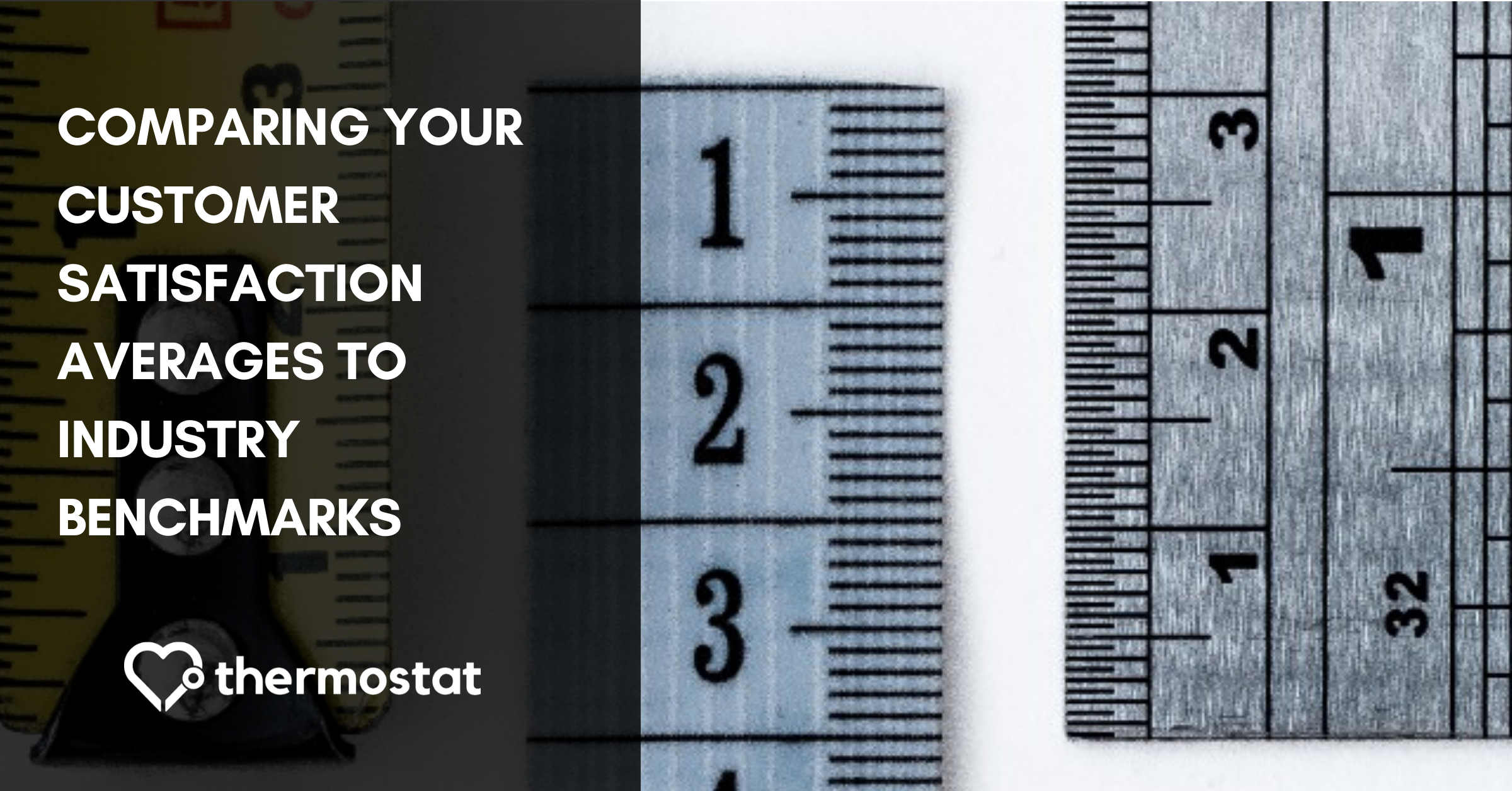How Do You Measure Up? Comparing Your Customer Satisfaction Averages to Industry Benchmarks

Ian Landsman
January 13, 2020

No matter what industry you work in, chances are that you’re interested in how well your competitors are performing. There are a number of ways to assess your competition’s success (revenue, size of customer base, brand awareness, etc.), but perhaps the most strategic averages to look at in your industry are customer satisfaction and loyalty.
Knowing where you stand on the spectrum of customer satisfaction and loyalty in your industry can help you:
- Make adjustments to your customer experience if you’re falling behind.
- Forecast future growth, depending on how well your competitors are doing.
- Decide if you need to investigate the processes and practices of specific, successful competitors–helping you to innovate and improve your own product and CX.
In this article, we’ll take a look at two industry benchmarks to help you get a grasp on where you stand in relation to the competition.
Blog readers get %5 off paid plans for life with code: blog
Benchmark #1: Customer Satisfaction
Customer satisfaction indicates how satisfied your customers are with your product or service, and with their experience as a consumer. It can refer to a customer’s satisfaction with a specific experience, transaction, or product, or it can refer to a customer’s overall impression of your brand.

In general, customer satisfaction is measured with a metric called CSAT.
CSAT is gathered simply by asking your customer base, How would you rate your overall satisfaction with product/service X?
Survey takers typically provide a rating on a scale of 1-5.
Customers who gave you a 4 or 5 are considered “very satisfied.” Anyone who gives you a 3 or below is considered “unsatisfied.”
To calculate your CSAT, you’ll divide the number of satisfied customers (4’s and 5’s) by the number of unsatisfied customers (3’s and below). Then multiply by 100 to get the percentage of satisfied customers relative to unsatisfied customers.
[(# of satisfied customers) / (# of unsatisfied customers)] x 100 = CSAT
Now that you’ve got your CSAT, you’re ready to see how you’re measuring up to industry benchmarks...
Comparing Your Customer Satisfaction Score to Industry Benchmarks
Depending on the industry you work in, your level of customer satisfaction might range pretty wildly. Some industries tend to have a fairly high level of satisfaction on average (Breweries, Food Manufacturing), while others sell products or services that may make it harder to please (Airlines, Internet Service). Let’s take a look at a fairly comprehensive list from 2019:
- Breweries: 84
- Food Manufacturing: 82
- Airlines: 74
- Wireless Telephone Services: 75
- Life Insurance: 80
- Personal Computers: 78
- Personal Care and Cleaning Products: 83
- Cellular Telephones: 79
- Internet Retail: 80
- Banks: 80
- Full-Service Restaurants: 81
- Internet Service: 62
- Internet News and Opinion: 77
- Internet Investment Services: 81
- Supermarkets: 78
- Apparel: 77
As you can see, most scores hover around 80. Let’s say you sell an all-natural cleaning product. Your industry benchmark is 83. If your average is significantly lagging behind this score, you’re going to want to quickly take action to improve customer satisfaction. This can be done in several different ways:
- Ask your customers for open-ended feedback. This can be done during the initial survey, or in a separate survey. What do they like about your product or service? What are they disappointed with? What do they think could be changed?
- Take a look at what your competitors are doing differently. How can you adopt similar processes or features to potentially improve your brand?
- Walk through your customer experience as an anonymous consumer. Call your customer support. Refund or exchange an item. Buy multiple items (or services), and try them all out.
In the case that you’re ahead of the industry benchmark, congrats! On average, you’re generating a greater level of satisfaction than others in your same industry.
Knowing that you’re performing well, however, is no reason to sit still. If you’re outscoring others in your industry in terms of satisfaction, you should know why. Do you offer a great price for the value you provide? Have you innovated a useful new feature? Does your support team go above and beyond to support customers?
Whatever makes your customer satisfaction exceptional, make sure to continue honing that strategy–and offering your buyers a quality experience and product/service.
Benchmark #2: Net Promoter Score
Net Promoter Score (NPS) is a CX-focused metric that measures customer loyalty, rather than satisfaction. What’s the difference between the two? Customers who are satisfied may be happy with your product or service, but they’re not necessarily long-term buyers. Once a less-expensive, sexier brand comes along, your otherwise satisfied customers may churn to try something different.
But a loyal customer is likely to stick with your product or service for the long haul. They’re also likely to spend more, complain less, and make valuable referrals. Satisfaction is desirable. But loyalty is clutch.
Net Promoter Score measures customer loyalty by deploying a survey, calculating and assessing results, and continuing to track the score (made significantly more efficient and easier by using an NPS software). The survey asks customers:
How likely are you to recommend X to a friend, family member, or coworker? Please provide your answer on a scale of 0-10 (0 being not likely, 10 being very likely).
As a result, survey takers are put into one of three categories: Promoter (9 or 10), Passive (7 or 8), or Detractor (6 or below).
Then, Net Promoter Score is calculated using this formula:
[# of promoters / Total # of survey takers] - [# of detractors / Total # of survey takers] = NPS
Now that you’ve got your NPS, you’re ready to look at industry benchmarks, and see how you match up…
Comparing Your Net Promoter Score to Industry Benchmarks
Keep in mind that Net Promoter Score tends to be lower than customer satisfaction. That’s because any number above zero indicates that you have more promoters than detractors–and anything below zero indicates that you have more detractors (a zero would indicate a perfectly split number).
That being said, while a customer satisfaction score of 50 would be considered abysmal, an NPS of 50 would be considered excellent.

Now that we’ve got that squared away, let’s take a look at average Net Promoter Scores for different industries:
- Online shopping: 43
- Auto Insurance: 39
- Laptop Computers: 36
- Credit Cards: 37
- Smartphones: 34
- Cable/Satellite TV: -6
- Internet Service: -7
- Life Insurance: 26
- Banks: 34
- Software and Apps: 30
- Grocery/Supermarkets: 32
As a point of reference, notice that Internet Service performs poorly in both customer satisfaction and NPS categories (62 and -7, respectively). Banks and supermarkets, on the other hand, do pretty well (80/34 and 78/32).
Interestingly enough, consumers provide the highest NPS for online shopping brands–indicating that it’s more than possible to gain powerful loyalty without a storefront.
If your NPS falls behind your industry average, don’t panic! Again, it’s simply time to strategize to move your score up.
The most powerful way to do this is to ask your customers for open-ended feedback that explains their score. You’ll follow up the original NPS question by asking: Please explain your answer.
Using an NPS software, you’ll be able to dive into this open-ended feedback by tagging, organizing, and filtering feedback according to customer category (Promoter, Detractor, or Passive). Then, take a look at what detractors have to say. Did they have a frustrating experience with your customer support? Have they been disappointed with your overall product?
Identify common themes and take action to make improvements. Then, measure your NPS again. By listening to your customers and making actionable changes, you should see positive improvements–indicating that you’re generating more loyal, valuable customers who will stick with your brand.
Your Most Important Competitor: Yourself
Comparing your averages to industry benchmarks is certainly valuable. But maybe the most valuable approach for improving customer satisfaction and loyalty is to compete against your own best score. By tracking your scores methodically and strategically, you’ll be able to note how specific changes are impacting customer satisfaction/loyalty, and how to project future growth. Ultimately, you are your most important competitor!
Blog readers get %5 off paid plans for life with code: blog
Our best articles, right to your inbox
